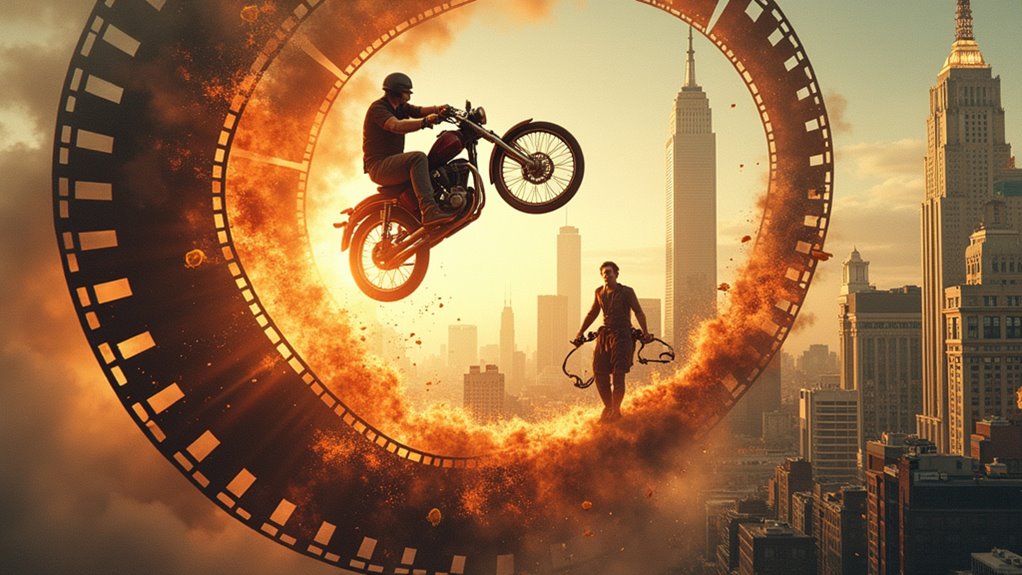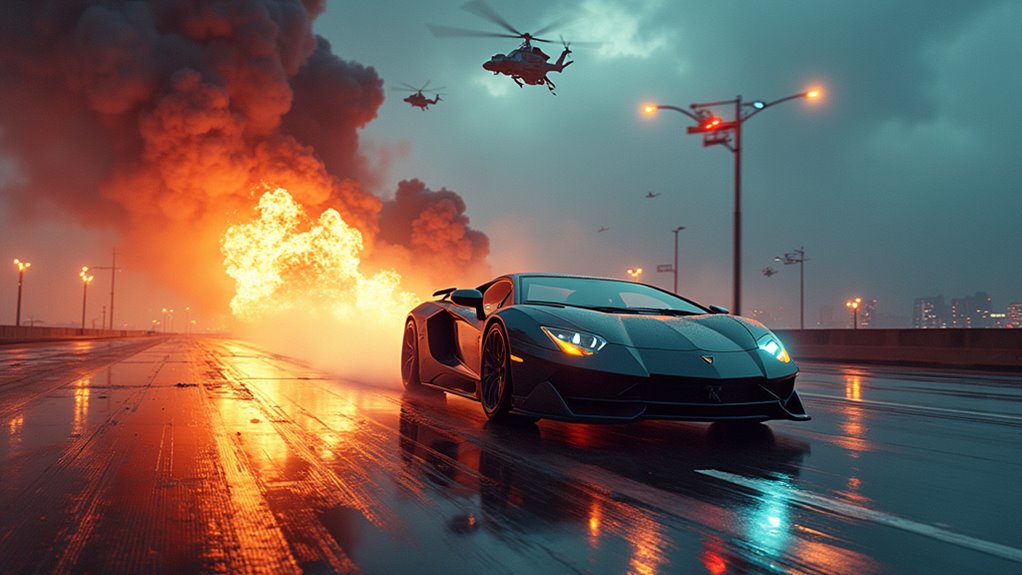From the gravity-defying stunts of “Mission: Impossible” to the martial arts mastery of “The Raid: Redemption,” today’s must-watch action films blend adrenaline-pumping spectacle with compelling storytelling. Classic favorites like “Die Hard” showcase everyday heroes in extraordinary situations, while international gems like “Crouching Tiger, Hidden Dragon” elevate the genre with poetic fight choreography. Modern entries continue pushing boundaries through innovative effects and diverse narratives, proving action cinema’s evolution shows no signs of slowing.
Evolution of Action Cinema: From Classics to Modern Masterpieces

While the earliest films were devoid of spoken dialogue, they laid the groundwork for modern action cinema through groundbreaking stunt work and innovative chase sequences. Silent stars like Harold Lloyd and Buster Keaton defied death with jaw-dropping stunts, while Douglas Fairbanks swashbuckled his way through early adventure epics, setting the template for future action heroes. The Odessa Steps sequence from Battleship Potemkin established revolutionary editing techniques that still influence modern action films.
The 1970s and ’80s ushered in action’s golden age, as Bruce Lee’s lightning-fast martial arts gave way to muscle-bound icons like Schwarzenegger and Stallone. The emergence of John Shaft as the ultimate suave black detective forever changed the representation of African American heroes in action cinema. These decades saw the rise of martial arts elements that would become a cornerstone of modern action filmmaking.
“Die Hard” revolutionized the genre in 1988, proving that everyday heroes could be just as compelling as indestructible super-soldiers.
By the early 2000s, “The Bourne Identity” had transformed action again with its gritty realism and frenetic camera work, while “The Matrix” merged philosophical themes with groundbreaking special effects.
Today’s action landscape, dominated by superhero spectacles and physics-defying franchise installments, continues to push boundaries while paying homage to its death-defying roots.
Global Impact: International Action Films That Changed the Game
Although Hollywood has long dominated the global film landscape, international action movies have fundamentally reshaped the genre through groundbreaking innovations and cultural crossovers. Films like Hong Kong’s “Police Story” and “Hard-Boiled” revolutionized martial arts choreography, while Indonesia’s “The Raid: Redemption” raised the bar for close-quarters combat sequences that would make even seasoned stunt coordinators break a sweat. Crouching Tiger, Hidden Dragon demonstrated how martial arts could blend seamlessly with stunning visuals and poetic storytelling.
The influence of international action cinema extends beyond pure adrenaline, with French thriller “La Femme Nikita” inspiring multiple remakes and Korean masterpiece “The Villainess” pushing the boundaries of what’s possible with long-take action sequences. With action films dominating nearly 60% of the box office by 2019, the genre’s global impact cannot be understated.
These films have not only captured audience imagination but also transformed Hollywood’s approach to action filmmaking. As international markets continue to grow, particularly in Asia, studios increasingly craft their blockbusters with global appeal in mind, resulting in more diverse casts, multicultural storylines, and fusion fighting styles that blend Eastern and Western techniques.
The Future of Action: Upcoming Releases and New Directions

As 2025 approaches, the action genre stands poised for dramatic evolution through an impressive slate of upcoming releases that blend traditional thrills with innovative storytelling approaches.
From Tom Cruise’s potentially final outing as Ethan Hunt in “Mission: Impossible – The Final Reckoning” to the intriguing fusion of martial arts legends in “Karate Kid: Legends,” the year promises groundbreaking entertainment. Cameron Diaz’s return in the Netflix action-comedy “Back in Action” alongside Jamie Foxx marks another exciting addition to the genre’s evolution. Similar to how The Matrix revolutionized visual effects in 1999, these upcoming films aim to push technological boundaries even further.
The landscape reveals a clear trend toward genre hybridization, with films like “The Toxic Avenger” starring Peter Dinklage mixing dark comedy with vigilante action, while “In the Lost Lands” adapts George R.R. Martin’s work into an action-fantasy spectacle. Advanced AI casting systems are revolutionizing how actors are matched to their roles, ensuring more dynamic on-screen chemistry.
High-concept thrillers such as “One Battle After Another” and “Black Bag” suggest a push toward more sophisticated narratives, while the advancement in special effects technology continues to raise the bar for visual spectacle.
This evolution signals a shifting paradigm where action films increasingly emphasize storytelling depth alongside their signature adrenaline-pumping sequences.
Frequently Asked Questions
Which Action Movies Have the Best Practical Effects Versus CGI?
Mad Max: Fury Road stands as the gold standard for practical effects, featuring real vehicle stunts and explosive sequences that put CGI to shame, while The Dark Knight’s practical approach to car chases and building demolitions created genuine tension.
The original Star Wars trilogy and Aliens demonstrate masterful use of miniatures and practical creature effects, though modern films like Inception blend CGI seamlessly with practical stunts and effects.
How Do Stunt Performers Prepare for Dangerous Action Sequences?
Stunt performers undergo rigorous physical training and detailed preparation before attempting dangerous sequences.
They start with extensive martial arts and combat training, followed by meticulous choreography rehearsals under qualified stunt coordinators.
Safety protocols, including risk assessments and protective gear requirements, are strictly enforced.
Performers practice stunts repeatedly in controlled environments, gradually building complexity while maintaining constant communication with the safety team and coordinators to refine techniques and address concerns.
What Are the Most Expensive Action Scenes Ever Filmed?
The most expensive action scenes include the Battle of Borodino from “War and Peace,” valued at $100 million in today’s money, followed by the “Burly Brawl” sequence from “The Matrix Reloaded” at $40 million.
Notable mentions are “Spectre’s” $32 million Rome car chase, “Ben-Hur’s” iconic chariot race at $42 million adjusted, and “I Am Legend’s” Brooklyn Bridge collapse at $5 million.
Which Actors Perform Their Own Stunts in Action Movies?
Tom Cruise and Jackie Chan stand out as Hollywood’s most committed stunt performers, with Cruise famously executing HALO jumps and helicopter maneuvers in Mission: Impossible, while Chan’s acrobatic prowess defined Hong Kong action cinema.
Keanu Reeves tackles intense combat sequences in John Wick, and Jason Statham brings his martial arts background to his action roles.
Angelina Jolie and Charlize Theron consistently perform their own physically demanding stunts in blockbuster films.
How Do Different Countries’ Ratings Systems Affect Action Movie Violence?
Different countries’ rating systems create a complex web of standards that directly impacts how action movie violence is presented globally.
While the US MPAA might slap an R-rating on intense combat scenes, European systems often show more leniency, allowing younger viewers to access similar content.
This variance leads studios to create multiple cuts of films, strategically editing violence to secure favorable ratings in key markets while maintaining artistic vision.
